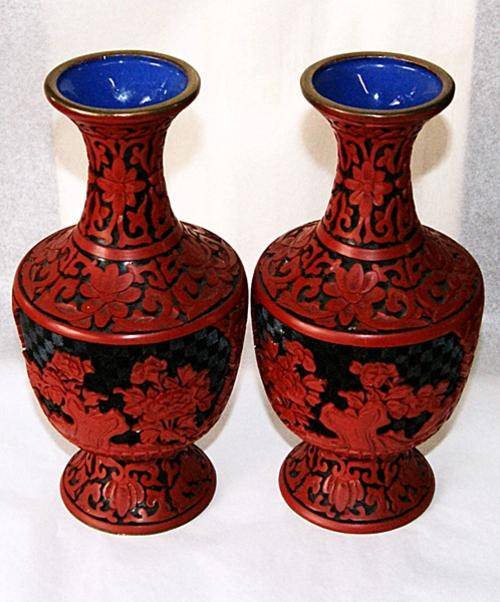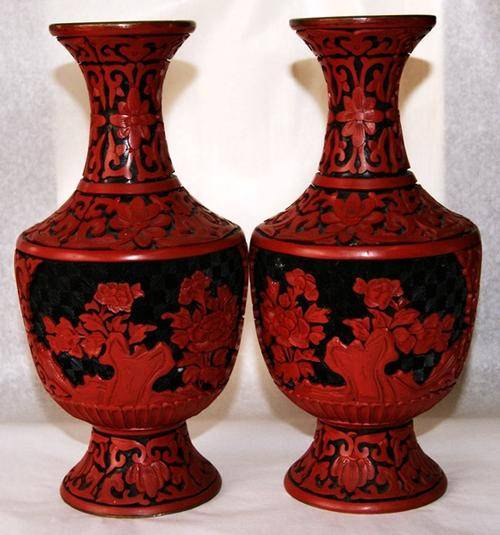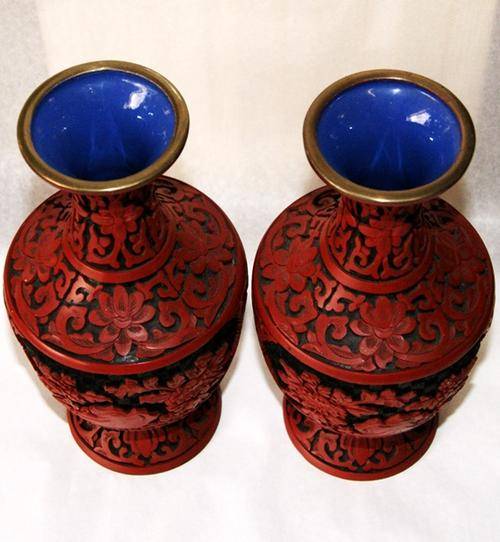
PAIR OF OLD HAND CARVED ORIENTAL CINNABAR VASES... GORGEOUS DETAIL@@@ CRAAZZYYY R1 START
Check my rate
| Main centres: | 1-3 business days |
| Regional areas: | 3-4 business days |
| Remote areas: | 3-5 business days |

| Main centres: | 1-3 business days |
| Regional areas: | 3-4 business days |
| Remote areas: | 3-5 business days |
PAIR OF CARVED ORIENTAL CINNABAR LACQUER VASES
HIGHLY ORNATE AND DETAILED CARVING
EXTREMELY RARE
EXTREMELY VALUABLE!!!!
SIZE = 20.5cm H
From the estate of Greta Abrahamson
Lacquered art pieces have been produced in China for many centuries. Lacquer is produced from the sap of the lac tree, which is commonly found in central and southern China. Various pigments are added to the resulting lacquer to change its color, and then the lacquer is applied in many coats to an art object. After many coats, the lacquer is carved, producing unique designs, patterns, and subjects. One lacquer, which was prominent throughout China, was cinnabar lacquer, which was made by mixing a seemingly innocuous mineral called cinnabar with lacquer. Cinnabar lacquer was used on a wide variety of pieces ranging in size from jewelry pieces to large ceramic or metal vases.
Cinnabar is a mineral that appears near volcanoes or hot springs. It is rich in mercury and, when ground into a fine powder, produces a deep red tint.
The production of a cinnabar lacquer piece is a fascinating and time consuming process. First, the base work was produced, whether it was a vase or a brooch. Next, layer after layer of cinnabar lacquer was applied. Often layers would alternate in color to achieve a multicolor effect in the design, and some pieces would feature more than 300 coats of lacquer. Each layer would have to dry before a new one was applied, so some pieces could take almost half a year to prepare some larger pieces could take years! Once the lacquer layers had reached the correct depth, the carving process could begin.
Carving a cinnabar lacquer piece was a very delicate process, and could take the artist many years to complete. Care was needed, since a slip could require filling with many new layers of lacquer or could necessitate a complete re-do of the entire project. Once the carving was finished, another layer of lacquer would be added to seal the carving. Clear lacquer with no cinnabar was often used in this final step to keep the piece from spreading mercury to the skin ??this was especially important for jewelry pieces.
Many cinnabar lacquer pieces are still available at auction, and are highly prized for the richness of color and intricacy of carving. Minimizing exposure to these older pieces is essential to prevent any contamination, but pieces kept behind glass can still be a valuable part of any collection. While true cinnabar lacquer pieces are hardly ever produced today, many carvers work with simulated chemical cinnabar in their lacquer. This has allowed carved lacquer pieces to remain in production, without the harmful effects possible when working with cinnabar.
to view my other items click the link below
http://www.bidorbuy.co.za/seller/404246/dame8








payment within 48 hours
collections welcome
insurance optional and charged at 2% of sale price
cash deposits please add R16.50
i reserve the right to close my auctions at any time
i am not responsible for damages to items whilst in the care of SAPO
if you are worried about the item you have purchased please add the insurance costs
PLEASE MAKE SURE YOU HAVE VIEWED ALL PICTURES CAREFULLY AS PICTURES FORM AN IMPORTANT PART OF THE DESCRIPTION
by bidding on this item you understand that it is a vintage/antique/old item and thus is sold as such, no warranty or guarantee is implied, expressed or stated on vintage items. the item is sold as is and its condition has been described to the best of our ability. should you require any further information please ask via the questions.